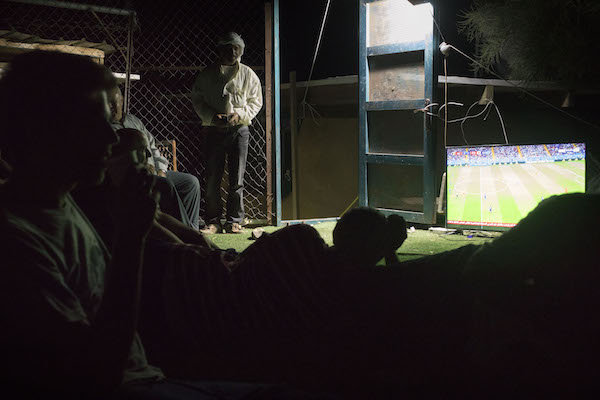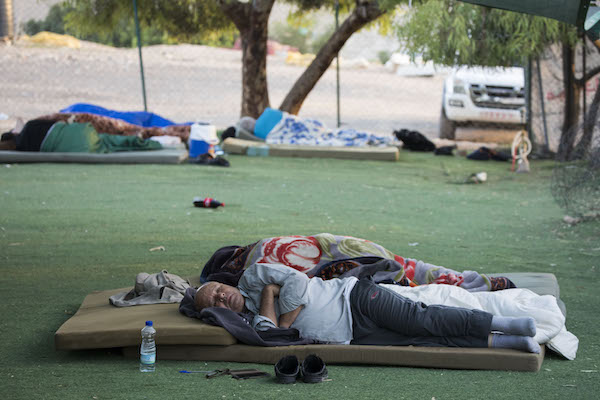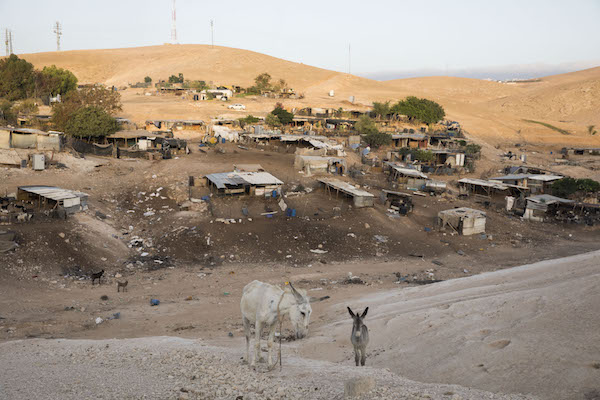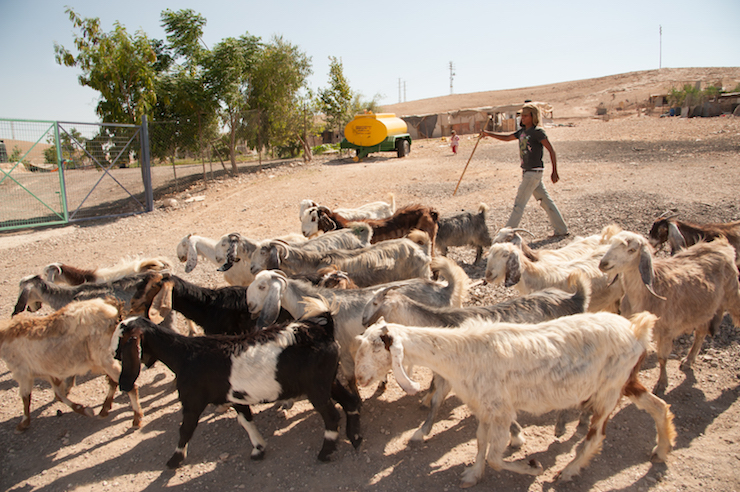The residents of Khan al-Ahmar, a tiny hamlet in the West Bank, live in constant fear of a demolition that could come any day now. Dozens of activists take turns staying the night, passing the time by arguing over politics and the World Cup. But despite the numbers, the villagers know that once the bulldozers come, it will be impossible to stop them.
By Oren Ziv

The activists heading to Khan al-Ahmar, a tiny Bedouin village in the West Bank slated for demolition, had a tough choice to make: should they head out from Jerusalem before or after the World Cup match between Japan and Belgium. They eventually settled on a compromise — they left at halftime. At night, the ride from central Jerusalem to the hamlet is short. A few kilometers past the settlement of Ma’ale Adumim, there is a small parking lot intended for hikers. But instead of setting off on the path for Nahal Og, the activists walk through an underpass under the main road and reach the village, comprised of a few dozen homes, and a school made of mud and tires.
The activists gather in the school, whose floor is covered in artificial turf. The majority of those present are Palestinian men, who are here to prevent the imminent evictions. For a moment it appears that electricity problems have put the kibosh on the second half of the match, which was broadcasted on a plasma television that someone had brought from home. Very quickly, however, the electricity from the generators and solar panels comes back to life. The vast majority of the crowd supports the Belgians.
“They are testing us,” says Ibrahim Abu Dawoud, 51, who was born in Khan al-Ahmar and has lived here all his life, following the multiple visits by Israeli authorities to the village. This past week, representatives of the Civil Administration, charged with running the day to day of Palestinians under occupation, accompanied by police officers arrived to plan for the demolition. That same night, rumors spread that the eviction would take place the following morning. The village was not destroyed, but residents and activists have been living with the possibility that it could happen any day now.
“They want to check how much pressure we can withstand,” Abu Dawoud adds, just as Japan scores the second goal. “They sent a bulldozer last Tuesday to start doing work for the electricity company, they wanted to see how we would react — whether we would call activists or the media, but we remained calm,” he explains. The government wants to push the residents to a new community, bereft of agricultural land, adjacent a garbage dump near Jerusalem. “For us, leaving the desert is death,” Abu Dawoud remarks.

“We don’t have a back up plan or another living option. We are not planning on going anywhere,” he says, adding that he sleeps an hour or two every night and hardly goes to his job as a tour guide. “If you give me a home in Tel Aviv, I won’t take it. Just like you cannot take a fish pout of water, you won’t take me out of the desert.” Last Monday, the Civil Administration reps came to his home, handing out demolition orders to his goat pen, which they claimed was “new construction.” “One of the goats poked its head out of the pen and ate the order. They didn’t bother putting up another one.”
In late May, following a years-long legal struggle, Israel’s High Court of Justice gave the green light to demolish Khan al-Ahmar and evict its residents, who were first expelled to the area from the Negev Desert by the Israeli military after 1948. Meanwhile, the government is preparing new plots of land for the evictees — located near the towns Abu Dis and Azariya. The villagers believe the demolition is only a matter of time.
The new Nakba
Despite the threats, people are in good spirits. Palestinian activists from the popular committees sit alongside representatives of the Palestinian Authority, as well as activists from the West Bank and Jerusalem — smoking nargilah and arguing over soccer and politics. “We must oppose this transfer, this is the new Nakba,” says Abdullah Abu Rahme, one of the leaders of the struggle against the separation wall in Bil’in, who works in the PA’s Wall and Colonization Resistance Commission. This is his 14th day sleeping in Khan al-Ahmar. “I come here every evening, stay until 8 a.m., and then drive to work in Ramallah. After work I stop by home for two hours and come here.”
“We come here to maintain our humanity,” he adds, “it is inconceivable that in the 21st century an entire community is going to be evicted, and that in a single night they will destroy their homes, livelihood, and school, which serves 180 students.” Despite the summer break, the school hosts activities for children on a daily basis.
The gathering is reminiscent of the Palestinian “outposts” established by the popular committees across the West Bank. At the time, activists built tents in an area known as E1, where Khan al-Ahmar is located, to protest the Israeli government’s plans to build settlements in the area that would effectively bisect the West Bank in two. At a time when the popular struggle against the wall has dwindled, the presence of dozens of activists in the village is a ray of hope.
“The protest camps we build in previous years were an attempt to bring the issue to the public agenda and to prevent evictions,” Abu Rahme says. “Of course, Israel will first of all evict Khan al-Ahmar — this is a large, well-known community that has a school. But it won’t stop there. There are another 46 Bedouin communities in E1 and East Jerusalem that are in danger of being evicted.”
Residents of nearby village Jabal al-Baba, also under threat of demolition, arrive in Khan al-Ahmar for a visit. Last week, a delegation from al-Araqib, an unrecognized Bedouin village in the Negev that has been demolished by Israeli authorities over 120 times, came to show their solidarity. “It is so touching that so many people are coming, and today is considered a small turn out,” says Muhammad, a 28-year-old who lives in Ramallah. Originally from the northern West Bank, Muhammad has slept in Khan al-Ahmar every day for the past two weeks. “I believe that our presence here strengthens the residents. Most of the demolitions occur without anyone paying attention,” he adds, pointing at the group, their eyes glued to the match.

The activists from Jerusalem are part of a new activist group, “Friends of the Jahalin,” named after the tribe to which the residents of Khan al-Ahmar belong, and which includes residents of the settlement Kfar Adumim who oppose the eviction. Israeli activists from grassroots anti-occupation groups such as Ta’ayush and Combatants for Peace come in shifts. On the drive from Jerusalem, one of the activists explains that the most critical hours to be at the village are between 2-6 a.m. The chances of preventing the demolitions are slim, he says, but the goal is solidarity with the residents, documenting the demolitions, and most importantly: organizing aid in its aftermath.
Ibrahim is very pleased with the solidarity. “We have gotten used to people wandering about,” he says when asked about the loss of privacy that comes with the around-the-clock presence of activists and journalists. Even during the day, small groups of activists come to the village and stay until the evening. “My young daughters ask why the state is doing this,” Ibrahim says. “They say that the people we know are nice. I tell them that the state is something else, not everyone is happy with it, Palestinians as well as some Israelis.”
Planning for the worst
At the 94th minute, Belgium scores its third goal of the game, beating Japan. The crowd erupts in cheers of joy, and after a minute the television screen goes black. The euphoria of victory disappears as the residents and activists prepare for another long night of waiting for the demolition. Half of them go to sleep on mattresses laid out in the schoolyard. The others stick around and chat until daylight.
The village homes are located just feet away from the highway that connects Ma’ale Adumim to Jerusalem. Despite the proximity, the night is quiet, the silence disrupted only by the sound of grasshoppers and the dogs keeping an eye on the goats. Inside his home, made of nylon sheets tied to wood, Ibrahim says that 30 years ago he had hundreds of goats. “We would take them to the hills to graze, sometimes all the way up to the north. Today we can’t go anywhere — everywhere you turn there is a wall.”

The hour is nearly one in the morning. “This is Palestinian land. We came here to sit with our brothers, to show sumud (Arabic for steadfastness) over the land and we are not moving from here,” says a young Palestinian from East Jerusalem to his friend who is recording on Facebook live.
The broadcast continues as the two walk around the activists, capturing every corner of the village to show those following that Khan al-Ahmar is full of people at every hour of the day. He asks the Israeli activists in Hebrew to say a few words. One of them looks into the camera and starts speaking: “We came to show solidarity with the village. They have lived here for many years and there is no reason for them to be evicted and that they won’t be able to continue living here for many more years. We will do everything we can to support the people and prevent the demolition from happening.”
As the sun begins to rise, some of the village residents take their goats and donkeys for a walk in the hills surrounding the homes. From a short distance, one can see the mound of dirt left by the bulldozers the day before. According to the residents, it is there to prevent access to the village during the demolition.
“If they come, we will try to prevent the demolition,” says a young Palestinian as he looks on to the main road. A few men from the village wait to be picked up for work in Jerusalem next to the guard rail, which blocks direct access to the village from the road. “But it will be hard to do so with such a small amount of people,” he admits. “If they have any indication of when the demolition will take place, hundreds will come to stand with the villagers.”
Oren Ziv is a photojournalist with the Activestills collective. This article was first published in Hebrew on Local Call. Read it here.

